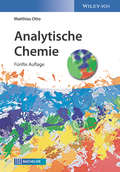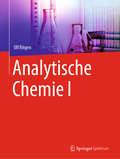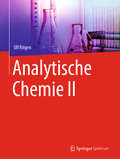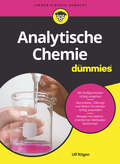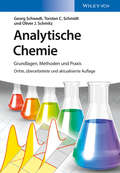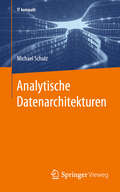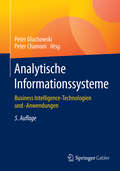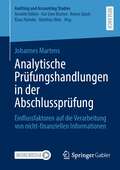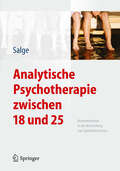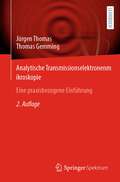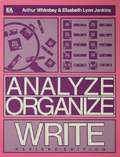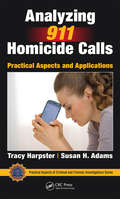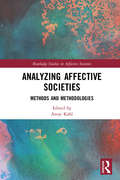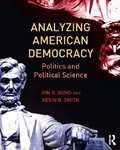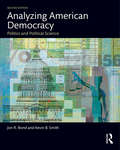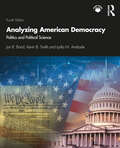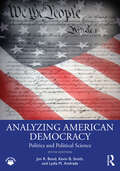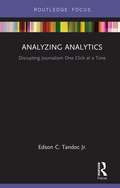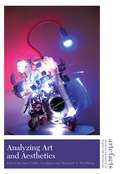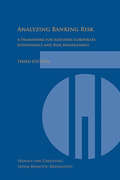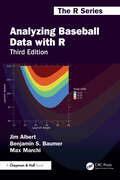- Table View
- List View
Analytische Chemie
by Matthias OttoDer "Otto" hat sich zu einem Standardwerk für Studenten der Chemie, Pharmazie, Lebensmittelchemie und anderer chemischer Disziplinen entwickelt, das auch von Nicht-Chemikern und Chemieingenieuren wegen seines didaktischen Aufbaus und seiner klaren Darstellung geschätzt wird. In fünfter, nochmals aktualisierter und um neueste Analysemethoden ergänzter Auflage, wird das gesamte Analytik-Wissen auf Bachelor-Niveau dargestellt. Mit dem Blick für das Wesentliche erklärt der Autor, worauf es bei den vielen heute gebräuchlichen Analysemethoden wirklich ankommt. Von den Grundlagen der qualitativen und quantitativen Analyse bis zu modernen Hochdurchsatz-Analysegeräten und der Qualitätssicherung wird die gesamte Bandbreite der modernen Analytik vorgestellt. Die fünfte Auflage bietet noch mehr Aufgaben und Lösungen zur Selbstkontrolle, außerdem zahlreiche Beispielrechnungen. Die Begriffe und Konstanten sind nach harmonisierten IUPAC-Definitionen aktualisiert. Eine blaue Schmuckfarbe wird im Buch verwendet, um einen noch effizienteren Lernprozess zu ermöglichen.
Analytische Chemie I
by Ulf RitgenDas Arbeitsbuch führt durch das erfolgreiche Werk Harris, Lehrbuch der Quantitativen Analyse und ist vor allem für das Selbststudium konzipiert. In fünf Teilen werden die Vorlesungsinhalte der Analytischen Chemie zusammengefasst und anhand ausgewählter Beispiele erläutert. Grundbegriffe der Analytik werden ebenso dargelegt wie das Prinzip und die verschiedenen Techniken der Maßanalyse und der Chromatographie. Anhand von UV/VIS-, Infrarot- und Raman-Spektroskopie wird die Untersuchung molekular vorliegender Verbindungen erklärt, mit ausgewählten Techniken der Atomspektroskopie findet die Einführung in die Grundlagen der Analytik ihren Abschluss. Dabei wird immer wieder auf essenzielle Abschnitte und Abbildungen des Lehrbuches verwiesen, was das selbstständige Lernen der Grundlagen der Analytischen Chemie erleichtert.Leicht lesbar führt das Buch in die Grundlagen und die wichtigsten Techniken der Analytischen Chemie ein; es richtet sich an Studierende im Grundstudium der Chemie oder verwandter naturwissenschaftlicher Fächer. Dabei wird immer wieder auf die aus Lehrveranstaltungen der Allgemeinen Chemie bekannten Grundlagen Rückbezug genommen, sodass die Zusammenhänge zwischen bereits Bekanntem und Neuem sofort erkenntlich werden. Das Lernen mit diesem Arbeitsbuch ist in einem Fernstudiengang Chemie erprobt und erleichtert die Vorbereitung auf Modulprüfungen der Analytischen Chemie.
Analytische Chemie II
by Ulf RitgenDieses Arbeitsbuch führt durch das erfolgreiche Lehrbuch Skoog/Holler/Crouch, Instrumentelle Analytik und ist vor allem für das Selbststudium konzipiert.In fünf Teilen werden die Vorlesungsinhalte der fortgeschritteneren Analytischen Chemie zusammengefasst und anhand ausgewählter Beispiele erläutert: Mit der Untersuchung von Molekülen befassen sich Massenspektrometrie und Kernresonanzspektroskopie, zudem werden zahlreiche elektroanalytische Methoden wie Potentiometrie, Coulometrie, Amperometrie und Voltammetrie behandelt. In einem Überblick über speziellere Verfahren der Analytik geht es unter anderem ebenso um den Einsatz radioaktiver Substanzen und die Nutzung verschiedener Fluoreszenzverfahren wie um Methoden der Informationsgewinnung in der zunehmend wichtigen elektrochemischen und optischen Sensortechnik sowie deren Automatisierbarkeit. Den Abschluss bildet eine Zusammenfassung verschiedener Prinzipien und Anwendungsmethoden der Statistik, die im Rahmen der Analytik schlichtweg unverzichtbar sind. Um das selbstständige Lernen zu erleichtern, wird dabei in allen Teilen des Buches immer wieder auf essenzielle Abschnitte und Abbildungen des Lehrbuches verwiesen.Nicht zuletzt aufgrund der zahlreichen Beispiele führt das Buch, das sich an Studierende der Chemie oder verwandter naturwissenschaftlicher Fächer richtet, leicht nachvollziehbar auch in komplexere Aspekte der Analytischen Chemie ein. Dabei wird in direkter Fortführung des Arbeitsbuches Analytische Chemie I immer wieder auf bereits bekannte Grundlagen aus anderen Lehrveranstaltungen verwiesen, die das Verknüpfen von Vertrautem und Neuem erleichtern. Das Lernen mit diesem Arbeitsbuch ist in einem Fernstudiengang Chemie erprobt und erleichtert die Vorbereitung auf Modulprüfungen der fortgeschritteneren Analytischen Chemie.
Analytische Chemie für Dummies (Für Dummies)
by Ulf RitgenDie Analytik ist zwar ein grundlegendes Thema innerhalb der Chemie, hat es aber ganz schön in sich. Aber keine Sorge, Ulf Ritgen erklärt Ihnen in diesem Buch was Sie zur Analytischen Chemie Wissen sollten. Wie erhält man eigentlich analytische Infos? Welche Standards gibt es? Und wie sollte man überhaupt mit den Stoffgemischen umgehen? All diese Grundlagen werden ausführlich erläutert. Aber auch die Anwendungsgebiete und Methoden kommen keinesfalls zu kurz. Egal ob Gravimetrie, Titration, Fällung oder Konduktometrie, endlich wird alles verständlich erklärt. Jetzt können Prüfung und Praktikum kommen!
Analytische Chemie: Grundlagen, Methoden und Praxis
by Georg Schwedt Oliver J. Schmitz Torsten C. SchmidtAlle relevanten Aspekte der Analytischen Chemie werden in diesem Lehrbuch, das gleichzeitig auch als Referenz fur Praktiker dient, umfassend und klar auf den Punkt gebracht. Das Autorenteam wird durch zwei aktive und international bekannte Professoren verstarkt; dies sorgt fur frischen Wind, gleichzeitig wird der didaktisch ausgefeilte Stil der Vorauflagen beibehalten. Von der Analysenstrategie zur Probenvorbereitung, von der Ma?analyse uber spektroskopische und chromatographische Methoden bis zur Automatisierung - DAS Lehrbuch fur alle, die sich mit Analytischer Chemie beschaftigen.
Analytische Datenarchitekturen (IT kompakt)
by Michael SchulzLange Zeit waren Data Warehouse, Data Mart und Operational Data Store die einzigen verbreiteten Komponenten einer analytischen Datenarchitektur. Die zunehmende Verwendung komplexer Daten zur Entscheidungsunterstützung hat in den letzten Jahren Architekturkomponenten wie den Data Lake oder Möglichkeiten zur analytischen Verwendung von Stromdaten hervorgebracht. War ihr Einsatz in vielen Organisationen zunächst von Misserfolgen begleitet, haben sich mittlerweile Grundsätze etabliert, die einen sinnvollen Einsatz ermöglichen. Seit kurzem sind mit Data Lakehouse, Data Fabric und Data Mesh weitere Ansätze in der Diskussion. Durch diese Vielzahl existierender Ansätze ist der Themenkomplex unübersichtlich geworden und es wird immer schwieriger, den Überblick zu behalten. Genau darin liegt die Zielsetzung des vorliegenden Buches: Mit einem klaren Fokus auf derzeit relevante Architekturkomponenten sollen ihre Hauptmerkmale verdeutlicht werden.
Analytische Informationssysteme: Business Intelligence-Technologien und -Anwendungen
by Peter Gluchowski Peter ChamoniInformationssysteme für die analytischen Aufgaben von Fach- und Führungskräften treten verstärkt in den Vordergrund. Dieses etablierte Buch diskutiert und evaluiert Begriffe und Konzepte wie Business Intelligence und Big Data. Die aktualisierte und erweiterte fünfte Auflage liefert einen aktuellen Überblick zu Technologien, Produkten und Trends im Bereich analytischer Informationssysteme. Beiträge aus Wirtschaft und Wissenschaft geben einen umfassenden Überblick und eignen sich als fundierte Entscheidungsgrundlage beim Aufbau und Einsatz derartiger Technologien.
Analytische Prüfungshandlungen in der Abschlussprüfung: Einflussfaktoren auf die Verarbeitung von nicht-finanziellen Informationen (Auditing and Accounting Studies)
by Johannes MartensIn der Abschlussprüfung werden neben Informationen aus der traditionellen Analyse von finanziellen Daten zunehmend Informationen aus der Analyse von nicht-finanziellen Daten berücksichtigt. Die Nutzung von nicht-finanziellen Informationen ist hierbei kein neues Phänomen, jedoch ermöglichen jüngere datenanalytische Verfahren, wie z. B. Text-Data-Mining, die Auswertung bisher wenig beachteter, unkonventioneller Datenquellen, die zunehmend in die prüferische Urteilsfindung Eingang finden. In diesem Zusammenhang wird in dieser Arbeit aus einer verhaltenswissenschaftlichen Perspektive untersucht, welche Bedeutung nicht-finanzielle Informationen aus der Analyse von Wetter-, Strom- und Internetdaten zur Plausibilisierung der Umsatzerlöse im Rahmen einer analytischen Prüfungshandlung für Prüfer besitzen. Hierfür wird eine experimentelle Untersuchung mit Prüfern durchgeführt, die drei wesentliche Faktoren bei der Verarbeitung der nicht-finanziellen Informationen fokussiert: das Bedürfnis nach kognitiver Geschlossenheit, die Informationskonsistenz und der fraud-Risiko-Kontext. Die Ergebnisse deuten unter anderem auf einen Einfluss des Bedürfnisses nach kognitiver Geschlossenheit und der Informationskonsistenz hin. Die Befunde liefern interessante Einsichten für Prüfungspraxis und -forschung.
Analytische Psychotherapie zwischen 18 und 25: Besonderheiten in der Behandlung von Spätadoleszenten (Psychotherapie: Praxis)
by Holger SalgePsychotherapie mit Patienten im Übergang zum Erwachsenwerden Die Spätadoleszenz ist eine Zeit des Abschieds. Eines Abschieds von den Eltern, von einem gesellschaftlichen Schutzraum (der bis dato Handeln ohne allzu weitreichende Konsequenzen ermöglichte) und von kompensierenden Omnipotenz- und Grandiositätsvorstellungen. Durch den Verlust äußerlich strukturierender Gegebenheiten kommt in dieser Lebensphase die "innere Ausstattung" auf den Prüfstand. In der Versorgungspraxis besteht eine Besonderheit bei der Psychotherapie junger Erwachsener: Je nach Alter beim Behandlungsbeginn werden die jungen Patientinnen und Patienten von Kinder- und Jugendlichenpsychotherapeuten oder von Erwachsenentherapeuten behandelt. Die Praxis zeigt oft: Beide Therapeutengruppen sind unzureichend auf diese Patientengruppe vorbereitet. Praxisorientiert: Nutzen und Fallstricke in der Therapie Der therapeutische Umgang mit Patientinnen und Patienten in dieser Lebensphase (18-25 Jahre) stellt besondere Anforderungen an die Therapeutin, den Therapeuten und spielt sich ab im Spannungsfeld von - diagnostischer Unsicherheit und heftigen Gegenübertragungsreaktionen auf Seiten der Therapeutinnen und Therapeuten bzw. des therapeutischen Teams sowie - Sprachlosigkeit, Ambivalenz gegenüber dem therapeutischen Angebot, massiver Scham und (unbewusster) Angst vor der eigenen Destruktivität auf Seiten des jungen Patienten. Dieses Buch bietet eine praxisorientierte Einführung in die Besonderheiten der Psychotherapie mit Spätadoleszenten und jungen Erwachsenen. Geschrieben für analytische und tiefenpsychologische Psychotherapeuten in Ausbildung und Praxis, aber auch Praktiker anderer theoretischer Orientierung, die sich mit der Therapie und Beratung von Patienten zwischen 18 und 25 vertraut machen möchten
Analytische Transmissionselektronenmikroskopie: Eine praxisbezogene Einführung
by Jürgen Thomas Thomas GemmingDas Buch wendet sich an alle, egal ob im Studium, in technischen Berufen, oder in der Wissenschaft, die die sich für die analytische Transmissionselektronenmikroskopie interessieren und einen Überblick über diese Methode erhalten möchten. Insbesondere betrifft dies Personen, die an einem Transmissionselektronenmikroskop arbeiten wollen oder müssen, die aber noch keine spezielle elektronenmikroskopische Ausbildung durchlaufen haben. Das Buch basiert auf den Erfahrungen der Autoren bei der Unterrichtung von Studierenden, Promovierenden und in technischen Berufen Tätigen. Der Überblick über die analytische Transmissionselektronenmikroskopie umfasst die Schwerpunkte Optische Abbildung, Elektronenwellen, magnetische Linsen, Abbildungsfehler, Aufbau eines Transmissionselektronenmikroskops, Präparation dünner Proben, Justage des Mikroskops, Elektronenbeugung, Kontrastentstehung, Höchstauflösungselektronenmikroskopie, Rastertransmissionselektronenmikroskopie sowie Analytik mittels energiedispersiver Röntgenspektroskopie und Elektronenenergieverlust-Spektroskopie. Ein mathematischer Anhang erklärt grundlegende Formalismen zur Thematik.
Analyze This! Understanding the Scientific Method
by Susan GlassHow did Walter Reed solve the mystery of yellow fever? Will balls of different masses fall at the same speed? Is your cat right-pawed or left-pawed? The world around us is full of interesting questions. This series gives students the tools to find the answers! Students will discover how the scientific method has changed our lives, and will learn how to plan, design, and conduct their own investigations.
Analyze, Organize, Write
by Arthur Whimbey Elizabeth Lynn JenkinsThis book offers students a method for understanding and mastering the rhetorical patterns that comprise expository writing. Its exercises ask students to arrange jumbled sentences into logical order, forming model essays for standard rhetorical patterns such as comparison/contrast, classification, and thesis support. These techniques force students to see the basic logic of different writing patterns. The goal of Whimbey's workbook is to teach the student to write concise and original essays on any topic.
Analyzing 911 Homicide Calls: Practical Aspects and Applications (Practical Aspects of Criminal and Forensic Investigations)
by Tracy Harpster Susan H. AdamsThis book provides police investigators and homicide detectives with a practical method of analyzing 911 homicide calls to uncover the truth. A structured analysis of 911 homicide calls can directly aid in developing investigative leads, planning interviews and solving cases. Case examples present proven, reliable methods as to when a caller is telling the truth or not. This book lays out a framework to analyze the call to determine truth from fiction. Every member of the investigative team, from call-taker to first responder, investigator, coroner’s investigators, and prosecutor, can contribute to the success of investigations through their knowledge of 911 call analysis.
Analyzing Affective Societies: Methods and Methodologies (Routledge Studies in Affective Societies)
by Antje KahlIn recent years, research in the social sciences and cultural studies has increasingly paid attention to the generative power of emotions and affects; that is, to the questions of how far they shape social and cultural processes while being simultaneously shaped by them. However, the literature on the methodological implications of researching affects and emotions remains rather limited. As a collective outcome of the Collaborative Research Center (CRC) Affective Societies at Freie Universität Berlin, Analyzing Affective Societies introduces procedures and methodologies applied by researchers of the CRC for investigating societies as affective societies. Presenting scholarly research practices by means of concrete examples and case studies, the book does not contain any conclusive methodological advice, but rather engages in illustrative descriptions of the authors’ research practices. Analyzing Affective Societies unveils different research approaches, procedures and practices of a variety of disciplines from the humanities, arts and social sciences. It will appeal to students and researchers interested in fields such as Qualitative Research Methods, Emotions, Affect, Cultural Studies and Social Sciences.
Analyzing American Democracy
by Jon R. Bond Kevin B. SmithAnalyzing American Democracy teaches students to think analytically by presenting current political science theories and research in answering the engaging, big questions facing American politics today. It serves as both an introduction to American politics and to the discipline of political science by reflecting the theoretical developments and empirical inquiry conducted by researchers. Every chapter highlights the most current research and discusses related public policy. It demonstrates for students how to think critically and analytically, bringing theoretical insight to contemporary American politics. More than just a comprehensive overview and description of how American politics works, Jon Bond and Kevin Smith demonstrate how politics can be studied systematically. Throughout the text, they introduce students to the insights gleaned from rational choice, behavioral, and biological approaches to politics. Understanding these three social scientific models and their applications helps students get the most out of their American government course and out of this text--they learn a way of thinking that they can use to make sense of future challenges facing the American polity. A number of features help aid comprehension and critical thinking: Key Questions at the start of every chapter frame the learning objectives and concepts Politics in Practice boxes in every chapter encourage students to think critically about how practice compares with theory Tables, Figures, Charts, and Maps throughout present the empirical details of American politics, helping students gain quantitative literacy Top Ten Takeaway Points at the end of every chapter recap the most important points covered but also help students discern the general principles that make sense of the numerous factual details Key Terms are bolded in the text, defined in the margins, recapped at the end of the chapter, and compiled in a glossary, all to help insure that students can effortlessly master the vocabulary of American politics and political science in order to move on to the more important concepts.
Analyzing American Democracy: Politics and Political Science
by Jon R. Bond Kevin B. SmithHow can political science help you understand the world you live in? Modern approaches to the study of politics analyze why Congress, the president, the courts, and other political actors do what they do. Learning to think critically about power, institutions, and rules helps citizens engage constructively in politics and the wider world around them and helps us systematically identify false claims, biases, and misconceptions. Analyzing American Democracy teaches students to think analytically by presenting current political science theories and research in answering the engaging, big questions facing American politics today. It serves as both an introduction to American politics and to the discipline of political science by reflecting the theoretical developments and empirical inquiry conducted by researchers. Every chapter highlights the most current research and discusses related public policy. It demonstrates for students how to think critically and analytically, bringing theoretical insight to contemporary American politics. More than just a comprehensive overview and description of how American politics works, Jon Bond and Kevin Smith demonstrate how politics can be studied systematically. Throughout the text, they introduce students to the insights gleaned from rational choice, behavioral, and biological approaches to politics. Understanding these three social scientific models and their applications helps students get the most out of their American government course and out of this text--they learn a way of thinking that they can use to make sense of future challenges facing the American polity. A number of features help aid comprehension and critical thinking: Key Questions at the start of every chapter frame the learning objectives and concepts "Thinking Analytically" boxes demonstrate how political scientists answer pressing questions about the American polity and model critical thinking "Applying the Frameworks" boxes show why theory is so important in making systematic sense of the political world "New Directions" boxes will highlight cutting edge research in political science to highlight some of the big contemporary questions the book addresses Tables, Figures, Charts, and Maps throughout present the empirical details of American politics, helping students gain quantitative literacy Top Ten Takeaway Points at the end of every chapter recap the most important points covered but also help students discern the general principles that make sense of the numerous factual details Key Terms are bolded in the text, defined in the margins, recapped at the end of the chapter, and compiled in a glossary, all to help insure that students can effortlessly master the vocabulary of American politics and political science in order to move on to the more important concepts. NEW TO THE SECOND EDITION Updated coverage throughout includes Affordable Care Act in the context of federalism Death penalty debates Affirmative action Racism, homophobia, and hate crimes in the wake of Ferguson Weakening of the Voting Rights Act Gay marriage history and new developments Tea Party and traditional party interface Campaign finance upheaval The changing Congressional landscape and increasing political polarization Updated tables, figures, and photos present the empirical details of American politics, helping students gain quantitative literacy Landmark court cases, now highlighted and linked to key concepts Refreshed feature boxes reinforce the book's dedication to helping students understand the scientific approach to politics, incorporating intriguing new topics including genetics and public opinion, the biology of political participation, and evolution and the bureaucracy
Analyzing American Democracy: Politics and Political Science
by Jon R. Bond Kevin B. SmithThis is an introductory American politics text covering the constitutional framework of American government, political behavior and informal institutions, the formal institutions of American government, and a concluding chapter on public policy. Every chapter highlights the most current thinking in political science research and discusses related public policy. This text teaches students to think analytically by presenting current political science theories and research in answering the engaging, big questions facing American politics today. It serves as an introduction to the discipline by reflecting the theoretical developments and types of empirical inquiry conducted by researchers. New to the Third Edition: 2016 and 2018 election updates and analysis of their political and policy impact Social media’s growing influence on politics The impact of the alt-right and rising populism on elections and policy New trends in public opinion Weakening of the Voting Rights Act Campaign finance upheaval The changing congressional landscape Updated tables, figures, and photos present the empirical details of American politics, helping students gain quantitative literacy Landmark court cases, now highlighted and linked to key concepts Refreshed feature boxes reinforce the book’s dedication to helping students understand the scientific approach to politics, incorporating intriguing new topics including genetics and public opinion, the biology of political participation, and evolution and the bureaucracy
Analyzing American Democracy: Politics and Political Science
by Jon R. Bond Kevin B. Smith Lydia M AndradeFollowing one of the most contentious and truth-challenged presidential administrations and elections in U.S. history, there has never been a greater need for an American government text like this--evidence-based, critically thoughtful, and contemporary in tone and touch. This text teaches students to think analytically by presenting current political science theories and research in answering the engaging, big questions facing American politics today. It serves as an introduction to the discipline—covering the Constitution, political behavior, formal and informal institutions, and public policy--by reflecting the theoretical developments and types of empirical inquiry conducted by researchers. For introductory courses in American government, this text covers theory and methods as well. New to the Fourth Edition Provides 2020 election data updates throughout and examines policy implications of the ensuing changes in election laws across the country. Recaps controversial Trump administration policies and looks into the Biden administration’s early days. Offers strategic updates on the Covid-19 pandemic and the resulting economic crisis both in terms of questions of federalism as well as public policy. Considers the rise of new interest groups and social movements as well as the reckoning with racial injustice. Examines contemporary questions of social justice in light of civil rights and liberties as well as in terms of policy. Covers the death of Supreme Court Justice Ruth Bader Ginsberg, the battle to confirm her replacement, the addition of Justice Coney Barrett, and the policy implications of the shift in the ideological balance of the Court. For the fourth edition, a new co-author comes to the book with award-winning experience in diversity and teacher education as well as research interests in the presidency, women and politics, and foreign policy.
Analyzing American Democracy: Politics and Political Science
by Jon R. Bond Kevin B. Smith Lydia M AndradeProviding the tools for critical thinking, the fifth edition of Analyzing American Democracy: Politics and Political Science relies on statistical analysis, constitutional scholarship, and theoretical foundations to introduce the structure, process, and outcomes of the U.S. political system. Interpretation and implications of the 2022 mid-term elections and full results of the 2020 census are included, as are discussions of:: the January 6th commission, major developments in the Supreme Court, the Covid-19 pandemic, the Russian invasion of Ukraine, and other key political events that shape domestic, foreign, judicial, and economic policies. For introductory courses in American government, this text covers theory and methods as well. New to the Fifth Edition • New and updated statistical data reflecting the 2020 census and the 2022 midterm elections, and discussions of the implications of the data and the results. • Offers a retrospective analysis of the entire Trump presidency and the first years of the Biden presidency. • Examines contemporary questions of social justice and anticipates upcoming challenges to voting rights, affirmative action policies, health care and reproductive rights, and protections for ethnic minorities and the LGBT community. • Previews the policy implications of an increasingly partisan Supreme Court, recaps the controversial recent decisions on health care, abortion, and environmental policy, and covers the historic confirmation of new justice Ketanji Brown-Jackson.
Analyzing Analytics: Disrupting Journalism One Click at a Time (Disruptions)
by Edson C. Tandoc Jr.Analyzing Analytics: Disrupting Journalism One Click at a Time critically examines how journalists use web analytics in their work and the implications of that use. Now that web analytics has become deeply embedded in newsrooms, its impact on journalism is even more potent. Documenting the different ways web analytics has disrupted traditional journalism, the book provides a timely review of what we know so far about the place of web analytics in reporting, and maps a future research agenda. It conceptualizes web analytics as an object of journalism where audiences, businesses, technologists, and journalists confront one another, negotiating the contours of digital journalism in the process. Including newly developed theoretical frameworks as well as case studies and empirical projects, the book is ideal for journalism students, researchers, and professional journalists.
Analyzing Art and Aesthetics (Artefacts: Studies in the History of Science and Technology #9)
by Margaret A. Weitekamp Anne Collins GoodyearThis ninth volume of the Artefacts series explores how artists have responded to developments in science and technology, past and present. Rather than limiting the discussion to art alone, editors Anne Collins Goodyear and Margaret Weitekamp also asked contributors to consider aesthetics: the scholarly consideration of sensory responses to cultural objects. When considered as aesthetic objects, how do scientific instruments or technological innovations reflect and embody culturally grounded assessments about appearance, feel, and use? And when these objects become museum artifacts, what aesthetic factors affect their exhibition? Contributors found answers in the material objects themselves. This volume reconsiders how science, technology, art, and aesthetics impact one another.
Analyzing Balance-Sheet Vulnerabilities in a Dollarized Economy: The Case of Georgia
by Johan Mathisen Andreas BillmeierA report from the International Monetary Fund.
Analyzing Banking Risk (Fourth Edition): A Framework for Assessing Corporate Governance and Risk Management
by Hennie van Greuning Sonja Brajovic BratanovicAnalyzing Banking Risk: A Framework for Assessing Corporate Governance and Risk Management provides a comprehensive overview of topics focusing on assessment, analysis, and management of financial risks in banking. The publication emphasizes risk management principles and stresses that key players in the corporate governance process are accountable for managing the different dimensions of financial and other risks. This fourth edition remains faithful to the objectives of the original publication. It covers new business aspects affecting banking risks, such as mobile banking and regulatory changes over the past decade—specifically those related to Basel III capital adequacy concepts—as well as new operational risk management topics such as cybercrime, money laundering, and outsourcing. This publication will be of interest to a wide body of users of bank financial data. The target audience includes the persons responsible for the analysis of banks and for the senior management or organizations directing their efforts. Because the publication provides an overview of the spectrum of corporate governance and risk management, it is not aimed at technical specialists of any particular risk management area. *** Hennie van Greuning was formerly a Senior Adviser in the World Bank’s Treasury Unit and previously worked as a sector manager for financial sector operations in the World Bank. He has been a partner in a major international accounting firm and a controller and head of bank supervision in a central bank. Since retiring from the World Bank, he has chaired audit, ethics, and risk committees in various banks and has been a member of operational risk and asset-liability management committees. Sonja Brajovic Bratanovic was a Lead Financial Sector Specialist at the World Bank, after a career as a senior official in a central bank. With extensive experience in banking sector reforms and financial risk analysis, she led World Bank programs for financial sector reforms, as well as development projects. Since her retirement, she has continued as a senior consultant for World Bank development projects in the financial sector, as well as an advisor for other development institutions.
Analyzing Banking Risk: A Framework for Assessing Corporate Governance and Risk Management
by Sonja Brajovic-Bratanovic Hennie Van GreuningThis book provides a comprehensive overview of topics focusing on assessment, analysis, and management of financial risks in banking. The publication emphasizes risk-management principles and stresses that key players in the corporate governance process are accountable for managing the different dimensions of financial risk. This third edition remains faithful to the objectives of the original publication. A significant new edition is the inclusion of chapters on the management of the treasury function. Advances made by the Basel Committee on Banking Supervision are reflected in the chapters on capital adequacy, transparency, and banking supervision. This publication should be of interest to a wide body of users of bank financial data. The target audience includes persons responsible for the analysis of banks and for the senior management or organizations directing their efforts.
Analyzing Baseball Data with R (Chapman & Hall/CRC The R Series)
by Jim Albert Benjamin S. Baumer Max Marchi“Our community has continued to grow exponentially, thanks to those who inspire the next generation. And inspiring the next generation is what the authors of Analyzing Baseball Data with R are doing. They are setting the career path for still thousands more. We all need some sort of kickstart to take that first or second step. You may be a beginner R coder, but you need access to baseball data. How do you access this data, how do you manipulate it, how do you analyze it? This is what this book does for you. But it does more, by doing what sabermetrics does best: it asks baseball questions. Throughout the book, baseball questions are asked, some straightforward, and others more thought-provoking.”From the Foreword by Tom TangoAnalyzing Baseball Data with R Third Edition introduces R to sabermetricians, baseball enthusiasts, and students interested in exploring the richness of baseball data. It equips you with the necessary skills and software tools to perform all the analysis steps, from importing the data to transforming them into an appropriate format to visualizing the data via graphs to performing a statistical analysis.The authors first present an overview of publicly available baseball datasets and a gentle introduction to the type of data structures and exploratory and data management capabilities of R. They also cover the ggplot2 graphics functions and employ a tidyverse-friendly workflow throughout. Much of the book illustrates the use of R through popular sabermetrics topics, including the Pythagorean formula, runs expectancy, catcher framing, career trajectories, simulation of games and seasons, patterns of streaky behavior of players, and launch angles and exit velocities. All the datasets and R code used in the text are available for download online.New to the third edition is the revised R code to make use of new functions made available through the tidyverse. The third edition introduces three chapters of new material, focusing on communicating results via presentations using the Quarto publishing system, web applications using the Shiny package, and working with large data files. An online version of this book is hosted at https://beanumber.github.io/abdwr3e/.
